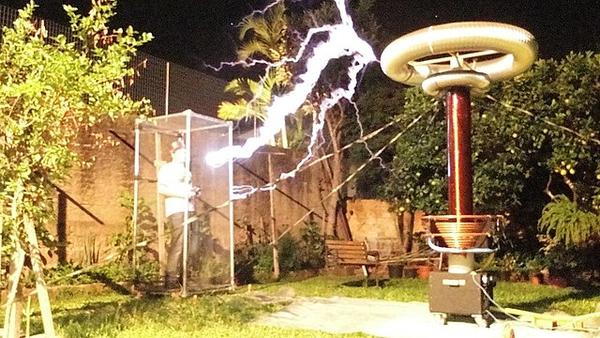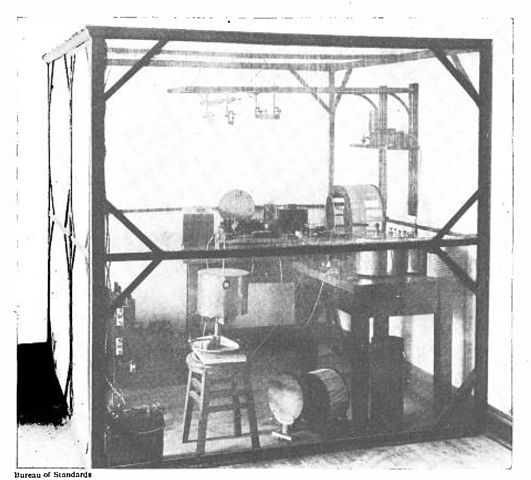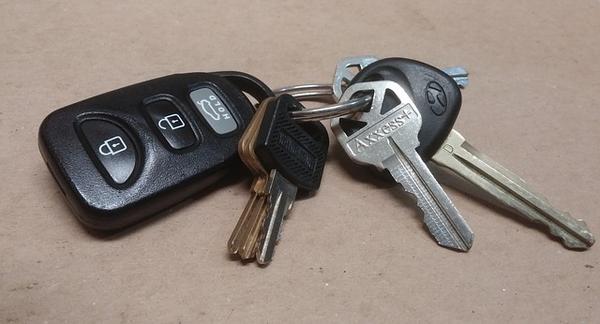You can’t see them, but there are electromagnetic waves all around us. The Earth’s magnetic fields create them. They are also emitted from many of the devices we use, such as radios and cell phones.
While electromagnetic waves alone don’t pose a threat, they can be manipulated by thieves. In the case of EMP, the electromagnetic fields could knock down the grid – quite literally plummeting us into a dark age.
That’s where a Faraday cage comes in.
A Faraday cage is a simple device that blocks electromagnetic fields. Here’s what you need to know about Faraday cages and why you might need one.
What Is a Faraday Cage?

The science behind the Faraday cage begins with Benjamin Franklin in the 1700s. When he wasn’t busy flying kites with keys on them, Franklin was doing all sorts of other experiments with electricity.
In one experiment, he electrified a silver can. Then he put a cork ball on a silk thread (both non-conductive).
When he dangled the ball outside of the can, the ball was drawn towards the walls of the can. But, when he lowered the ball inside the electrified can, the ball wasn’t drawn towards the sides. Franklin was at a loss to explain why this happened.
Many years later, an English scientist named Michael Faraday took Franklin’s discovery further.
Faraday found that when you charge a conductive material, the charge is only present on the surface and not on the interior of the conductor.
To test this, he lined an entire room with foil and then used a generator to charge the foil. He then put an electroscope (which detects electrical charges) in the room’s interior and found no charge going through.

This led to the invention of the Faraday cage in 1836.
A Faraday cage can be any sealed enclosure with an outer layer made from a conductive material and an inner layer made from a non-conductive material.
For example, a simple Faraday cage could be a filing cabinet lined with Styrofoam. The non-conductive lining prevents the charge from getting to the contents inside.
How Faraday Cages Work
The Faraday cage protects against electromagnetic radiation and pulses in two ways:
- The conductive outer layer reflects incoming pulses
- The conductive outer layer absorbs incoming pulses
Wait, the Faraday cage absorbs pulses?!?
This would seem to go against logic to someone without a physics background. Wouldn’t absorbing pulses cause anything inside the Faraday cage to get fried? This isn’t the case because of “field cancellation.”
As EMF Services explains:
A magnetic field can be thought of as a force that has both strength and direction. If it is met with an equal force of exactly opposite direction, the forces will cancel and the net force will be zero.

In layman’s terms, the pulse travels all around the conductive outer layer of the Faraday cage. It meets with other pulses, and they cancel each other out.
Why does this only work with conductive materials? As Lew Rockwell explains:
Field cancellation occurs when the free carriers in the conductive material rapidly realign to oppose the incident electric field. If the cage is made from something non-conductive, the free carriers are not mobile enough to realign and cancel the incident field.

Examples of Faraday Cages in Everyday Life
You may have seen a Faraday cage in a science museum (often demonstrated with a Tesla coil). But there are Faraday cages all around us. You might even be sitting in one now.
Here are just some examples of Faraday cages in everyday life.
Airplanes

Have you ever thought about why it isn’t dangerous to be in an airplane during a lightning storm? After all, a plane is a giant piece of metal flying in the sky and will draw lightning to it.
Well, it turns out that airplanes get hit by lightning all of the time – but that the plane acts as a giant Faraday cage to protect the people inside it.
The same goes for your car. If your car gets struck by lightning, the Faraday cage effect protects you – not the rubber tires.
Suits Worn by Linemen

Lineman working on power lines may wear special suits called “barehanded suits” (or conductive suits), which use the Faraday principle. This lets them work on live wires with their bare hands!
Microwaves

Microwave ovens have metal interiors. These, along with the mesh screen over the door, act as a Faraday cage to prevent the microwaves from leaking out while in use. If the door didn’t have that mesh, the microwaves would be able to escape.
Booster Bags
A booster bag is a shopping bag lined with aluminum foil, basically turning it into a Faraday cage. The bag blocks RFID surveillance technology used by retailers (the tag that beeps if you take it through the detectors at the door). This is such a known problem that some retailers have started adding metal detectors to their RFID machines. (source)
Police Departments
When evidence is on a computer, phone, or other digital device, criminals could completely wipe the data off the device. To prevent this, some police departments store digital evidence in Faraday cages.
MRIs
Magnetic resonance imaging machines are sensitive to radio frequency signals. The MRI scan room is a giant Faraday cage to protect the integrity of the scans.
Electronics
Many electronics are susceptible to electromagnetic fields. To protect them, many devices have Faraday cages built into them. For example, coaxial TV cables typically have copper braiding that acts as a Faraday cage.

Why Would You Need a Faraday Cage?
Up until recently, there wasn’t much interest in Faraday cages. But, as our world becomes more digital, people woke up to their uses.
1. Privacy and Security
When Micah Flee met with Edward Snowden, the first thing he did was put his phone and devices in a Faraday bag. Why? Because hackers can easily tap into our devices and spy on us.
If a hacker can access your phone or laptop (which they can with surprising ease), they will be able to do things like:
Determine your location
Turn on your microphone and eavesdrop on conversations
Spy on your through your video camera
Steal your data
Track keystrokes remotely (source)
For this reason, Brexit Secretary David Davis kept all his documents and electronics in a Faraday briefcase.
Note that Faraday cages aren’t perfect. As Tech Republic reports, a new method called the Odini Method can be used to penetrate devices within a Faraday cage. Plus, your phone will start transmitting the moment you take it out of the Faraday cage (i.e., whenever you use it). So, you won’t get privacy unless you are inside a Faraday cage.
Still, it’s pretty cool that Faraday cages can block phone and WiFi signals. Some universities are installing Faraday cages in their exam rooms to prevent cheating. And one clever bar user even built a Faraday cage around his entire bar! The idea was that maybe people would talk to each other once their phones were off.
2. Prevent Key Fob Theft

In 2015, the NY Times reported how thieves could hack into doors that use wireless key fobs. All they need is a simple device.
The device is called a power amplifier. It works by amplifying how far the door can search for the key. Usually, the car can only search for a few feet. But, as Wired reports, the vehicle can search for upwards of 300 feet with the amplifier.
If your car is parked near your home, the amplifier allows the vehicle to find the key inside your home. The key will unlock the door, giving thieves access.
One solution is to keep your wireless key fobs in your freezer or microwave (which acts as a Faraday cage). A better option would be to buy a Faraday key fob to prevent amplifiers from accessing them.
RFID Keyfob Blocking Bag
This RFID blocking key fob holder has good reviews, is affordable, and has a belt loop.
Faraday Bag for Key Fob
This one has a clip to secure it. Big enough to hold a key fob and bank cards.
3. Prevent Credit Card and Identify Theft
Some credit cards contain RFID chips that allow you to make payments without swiping the card. The card must be close enough to the terminal for the chip to be read. Likewise, US passports now contain RFID chips.
From the moment RFID chips made their appearance, critics argued that there could be security risks. There were videos of hackers using devices to copy the RFID data. All they had to do was get close enough to you to scan the RFID chip (crowded subway ride, anyone?).
Once the RFID chip was scanned, the hackers could create a clone card. Or, in the case of passports, make a cloned passport and steal your identity. The proposed solution is to get an RFID-blocking wallet or put a sheath of aluminum foil in your wallet.
While there have been plenty of stories about RFID card theft, there are also people who say that the threat is overblown or non-existent.
For example, Roger Grimes at CSO says, “there’s no real RFID crime.” He implies that the threat is overblown to sell you expensive wallets and purses.
Others, like LifeHacker, echo this claim, saying there is little evidence of RFID-based theft. They also note that modern contactless credit cards have technology like one-time-use codes to prevent theft.
So, should you get an RFID-blocking wallet?
The risk of getting your RFID card or passport cloned is overblown. But it still seems like there is a risk. It can’t hurt to take precautions and get an RFID-blocking wallet.
I just wouldn’t pay a fortune for the feature.
If you want an RFID-blocking wallet, here are some options:
4. Faraday Cages for EMP Protection
One of the reasons that Faraday cages get so much attention is for EMP protection. EMP stands for Electromagnetic Pulse. If you aren’t familiar with EMP, I suggest you first read this article about EMP and its effects.
In a nutshell, an EMP blast (whether from a weapon or solar flare) could knock out the electrical grid and potentially take out electronic devices with it. That includes:
- The electric grid
- GPS systems
- Cell phones and landlines
- Cars that rely on computerized and electric parts
- Radios
- All electric devices
While there is no consensus on what would occur during an EMP event, many worry that EMP could result in a “dark age.”
For example, Peter Vincent Pry, who heads the EMP Task Force on National and Homeland Security, believes that an EMP event would kill 9 out of 10 Americans.
The event itself isn’t dangerous – it’s that we rely on the electric grid for everything from supplying municipal water to food distribution.
Can a Faraday Cage Protect Against EMP?
The simple answer is maybe.
On one side, a Faraday cage could protect sensitive equipment from EMP. As NBC reports here, some utilities are already working on it – but safeguarding the grid from EMP would cost $10-$30 billion.
Others say that a Faraday cage won’t do much good against EMP. For example, EMF Services says that Faraday cages might not be 100% effective because,
The strength of a magnetic field often varies greatly across a given area, and the invisible lines of magnetic flux that constitute a magnetic field are often at inconvenient angles relative to the earth plane.
Faraday cages only work because pulses of equal strength cancel each other out; the cage might fail if the pulse isn’t radiating over the cage equally.
Further, even if a Faraday cage did keep your phone or other devices safe, what good will they be if the entire grid is down?
The Bottom Line?
We can’t know for sure whether a Faraday cage will completely protect against EMP. However, if you want to play it safe, put your crucial emergency devices in a Faraday cage. The devices you’d want to protect include:
Emergency radios and two-way radios
Flashlights
Generators
Batteries
Portable solar panels
Making a Faraday Cage
It is pretty easy to make a Faraday cage at home. You need a box made from a highly-conductive metal, such as aluminum. Many people have experimented with using refrigerators and microwave ovens as Faraday cages.
For example, Makezine found that a crude tinfoil box worked to prevent the key fob hack.
However, that was only for protection against the key fob hack. If you want to protect devices from stronger electromagnetic fields, you’ll need something sturdier.
For example, as MassLive reports, a police station tried to use a microwave oven as a Faraday cage to protect confiscated phones from being remotely wiped. Standard microwaves didn’t work. Only commercial-grade microwaves worked.
Key Notes about Making Your Own Faraday Cage:
The Box Must Close Completely: If there is a gap in your Faraday cage, signals will get in. Even tiny holes at doors/openings can let signals through. Some people recommend using copper tape or aluminum foil to cover gaps.
You can use mesh to make your box (more on this below), so long as the mesh goes around the entire area.
Using Mesh for a Faraday Cage: A Faraday cage does not have to be solid (hence the name cage). However, the holes in the mesh must be smaller than the wavelength you want to block. Generally, the mesh holes must be at most 1/10th of the wavelength you want to stop.
For example:
- Most US key fobs transmit at 315megahertz, which has a wavelength of .95 meters. So, a mesh with holes smaller than 9.5cm would work for a Faraday cage.
- Cellular wavelengths fall between 800 and 2400megahertz, which makes a wavelength of approximately 1 foot. You’d need to use a mesh of 1/10th or less of a foot.
- EMP from a nuclear or non-nuclear weapon could be below 100megahertz, which means the wavelength will be very short (possibly just a couple of centimeters). You’d have to use a fine mesh or a solid container to block these wavelengths.
Use Highly Conductive Metal:
For your Faraday cage to work well, it must be made of a highly-conductive metal.
Here are some good options for metal to use:
- Copper
- Aluminum
- Zinc
- Nickel
- Brass
- Bronze
- Iron
*Note that silver is one of the most conductive metals. But I doubt you’ll be using silver to make a Faraday cage!
For instructions on how to make your own Faraday cage, check out these videos:
Buying a Faraday Cage
Instead of making your own Faraday cage, you might just buy one. Many options exist, particularly for shielding phones, laptops, and small items.
We recommend checking out:
Testing Your Faraday Cage
Whether you make your own Faraday cage or buy one, you should test it to ensure it works.
The simplest way to test a Faraday cage is to put an FM radio inside it while it is tuned to a strong station. Once inside the cage, the FM signal should stop. If you can still hear the radio, then the Faraday cage isn’t working.
You can also try this test with a cell phone. Just put the phone inside the Faraday cage. It should not be able to receive any calls.
Unfortunately, testing a Faraday cage for EMP is much more complex, as pointed out here. You’d have to try it against high-magnitude waves at various frequencies.
While many articles and blogs say they’ve “tested” a homemade Faraday cage for EMP, they are just doing the cellphone test. We don’t know what would happen during an EMP event, so we can only hope that Faraday cages would protect devices.
Are you using a Faraday cage to protect your electronics? Did you make it yourself? We’d love to hear from you in the comments section.
https://science.howstuffworks.com/faraday-cage.htm
https://www.rivm.nl/en/Topics/E/Electromagnetic_Fields/EMF_dailylife
https://www.reference.com/science/conductive-metals-23c3aa1fbbaa72dd
https://www.techwalla.com/articles/what-type-of-wavelengths-do-cellphones-use
https://makezine.com/2015/08/14/block-car-door-relay-hack-faraday-cage/
https://www.researchgate.net/post/Is_steel_mesh_metal_a_good_shielding_to_RF











I agree with TX Griff that we should at least attempt to save some electronics. We’re making our Faraday out of an old, but never used, metal (often referred to as Aluminum, but a magnet sticks to it) trash can. It will be lined with cardboard on the insides and also the top/bottom. The bottom will have electrician tape to join bottom to sides to prevent the EMP surges from entering. The lid will be placed over all the goodies and taped down also. The top will be prevented from opening by either 2″ or greater CONDUCTIVE tape (hard to find) and additional tape crisscrossing the lid to the lower can body to be sure it stays down. BE sure to tape closed the gap between the can and the lid. If actual conductive tape can’t be found, then place a number of non-insulated wires crisscrossing the lid down to the can’s body. These will need to be tapped down to be sure they don’t get moved and to be sure the wires are held tight to the can.
The reason we are taking this much effort is that we want to be sure electronics and communications devices (walkie-talkie, etc.) are still useable. We also plan to place 2 or 3 laptops in for NON-Internet usage and possibly to charge some smaller devices. Needless to say, also some flash drives and external hard drives, with some games for entertainment. We’ll include solar panels and solar powered radios too. Some items will be wrapped in heavy-duty aluminum foil and then placed inside large freezer bags, just as an added precaution. These are just a few items we might need in a post-EMP world.
When the “FC” is ready to load I’ll stop and do a test using the radio, and of a cell phone, to see if the tape is even needed, which I suspect it will be.
Can you put multiple devices in one faraday cage? or is it not recommended and why?
Yes, that’s perfectly fine.
Would a metal cooler lined with cardboard and then lid sealed closed work? I have a couple different coolers dating from 50s-70s
It might work, but you’d have to test it. Apparently there are even apps on your phone that you can download to test faraday cages.
>> Further, even if a Faraday cage did keep your phone or other devices safe, what good will they be if the entire grid is down? <<
Cell phones & e-readers are an excellent (and massive) "library" storage area… military manuals, survival books, articles, YouTube videos, how-to-build whatever instructions, reference books (bibles, engineering plans, gardening references, medical textbooks, knitting/sewing/crocheting/weaving patterns and how-tos, caring for particular livestock, etc) not to mention entertainment books, games, movies, etc. 😉
If I'm bugging out post-EMP or CME, then having my two older cell phones, my older Kindle, and a half-dozen thumb drives plus the appropriate charging cables and solar chargers for each that I've stored in my homemade Faraday cage will be MUCH easier to transport than the equivalent books/binders/etc.
What most people don’t understand is, an EMP pulse is DC current. Transformers on the grid operate (in the US) on 60 cycles “off-on” every second. They will short out if hit by DC current. The power lines act like a large antenna bringing the EMP right to the transformers. And instantly you have a dead transformer. There are not enough transformers in stock to get the grid up and running for months or years.
>> There are not enough transformers in stock to get the grid up and running for months or years. <<
Agreed. My research says we could, over the span of a decade, m-a-y-b-e replace one in 40 large power transformers (LPTs) *if* our overseas allies who manufacture the majority of the world's LPTs aren't in the same boat as we are (basically bombed back to the mid-1800s) and *if* they want to assist us (how will our country pay for the number of LPTs we'll need?). No pun intended, but it's a very dark scenario.